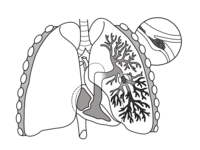
Photo from wikipedia
Pulmonary hypertension (PH) is a progressive condition with high mortality. At present, the most accurate diagnosis method is invasive. However, noninvasive methods existed are inaccurate, and could not be used… Click to show full abstract
Pulmonary hypertension (PH) is a progressive condition with high mortality. At present, the most accurate diagnosis method is invasive. However, noninvasive methods existed are inaccurate, and could not be used for continuous monitoring. The heart sound (HS) signals allow the earliest monitoring to diagnose a possible cardiovascular pathology. It has become an important tool for evaluating hemodynamic status of heart in outpatient monitoring. The primary aim of this study is to detect the PH disease using the HS signals. The authors develop and test a wavelet scattering convolution network (WSCN) based on long short term memory (LSTM) approach to detect the PH by using the HS signals. We conduct validation using 131 subjects through five cross‐validations. Six methods are used to test the different training strategies and models. We have validated our experiment based on subject dependent, subject independent, subject without segmentation, classification with feature extraction, classification without feature extraction, and classification by CNN and ensemble methods, respectively. Our best general model has a classification accuracy of 94.40%, which outperforms the previous best performance in terms of PH in the literature. The capability of the method is high as it is assessed by the five evaluation indicators, such as the accuracy, specificity, precision, sensitivity, and F1 score. Moreover, establishing the diagnosis with the WSCN+LSTM approach is less time cost. The WSCN based on the LSTM approach is developed to detect PH disease. The system for PH classification, allows for noninvasive assessment of a heart condition in suspect patients without many cost and without risk of invasive detection.
Journal Title: Computational Intelligence
Year Published: 2022
Link to full text (if available)
Share on Social Media: Sign Up to like & get
recommendations!